Understanding web data analytics: Definition, Evolution, and Applications

Understanding web data analytics: Definition, Evolution, and Applications
Overview
This article offers a comprehensive overview of web data analytics, defining it as a structured method for collecting and analyzing online data to gain insights into user behavior and enhance digital engagement.
The evolution of web data analytics is significant; it has progressed from basic log files to advanced tools such as Google Analytics. This advancement highlights its critical role in informed decision-making.
How can businesses leverage these insights to improve their marketing strategies in today's digital landscape? By understanding user behavior through these analytics, companies can make data-driven decisions that lead to more effective marketing strategies and ultimately, greater success.
Introduction
Web data analytics serves as a crucial compass in navigating the vast ocean of online interactions. It offers organizations a structured approach to gather and interpret data from digital sources. By harnessing this analytical power, businesses can uncover valuable insights into customer behaviors, optimize their marketing strategies, and enhance user experiences. However, as the digital landscape evolves, how can companies effectively leverage these insights to not only keep pace but also thrive amidst the competition?
Define Web Data Analytics
Web data analytics is an organized method of gathering, measuring, and examining information from online sources. This process is crucial for obtaining insights into visitor behavior, site performance, and overall digital engagement using web data analytics. Key metrics such as:
- Page views
- Unique visitors
- Bounce rates
- Conversion rates
are essential for evaluating the effectiveness of an organization's online presence. By utilizing web data analytics, companies can establish measurable goals that align with their overall strategy. This leads to evidence-based decisions that improve user experience, optimize marketing approaches, and ultimately promote growth.
For instance, a fashion retailer utilized heatmaps and visitor flow analysis to restructure their website navigation. This strategic adjustment resulted in a significant 20% increase in average session duration and a 15% boost in sales. Furthermore, web data analytics can assist companies in monitoring campaign performance across platforms such as Google Ads and Facebook Ads. By recognizing effective strategies and eliminating unnecessary expenditures, businesses can enhance their return on investment (ROI).
Industry leaders emphasize that investing in web data analytics is essential for achieving long-term growth and maintaining a competitive advantage in today's information-rich environment. By understanding user engagement metrics and customer needs, companies can refine their strategies and improve overall performance. This ensures they meet the evolving needs of their audience. How might your organization leverage these insights to enhance digital engagement and drive growth?
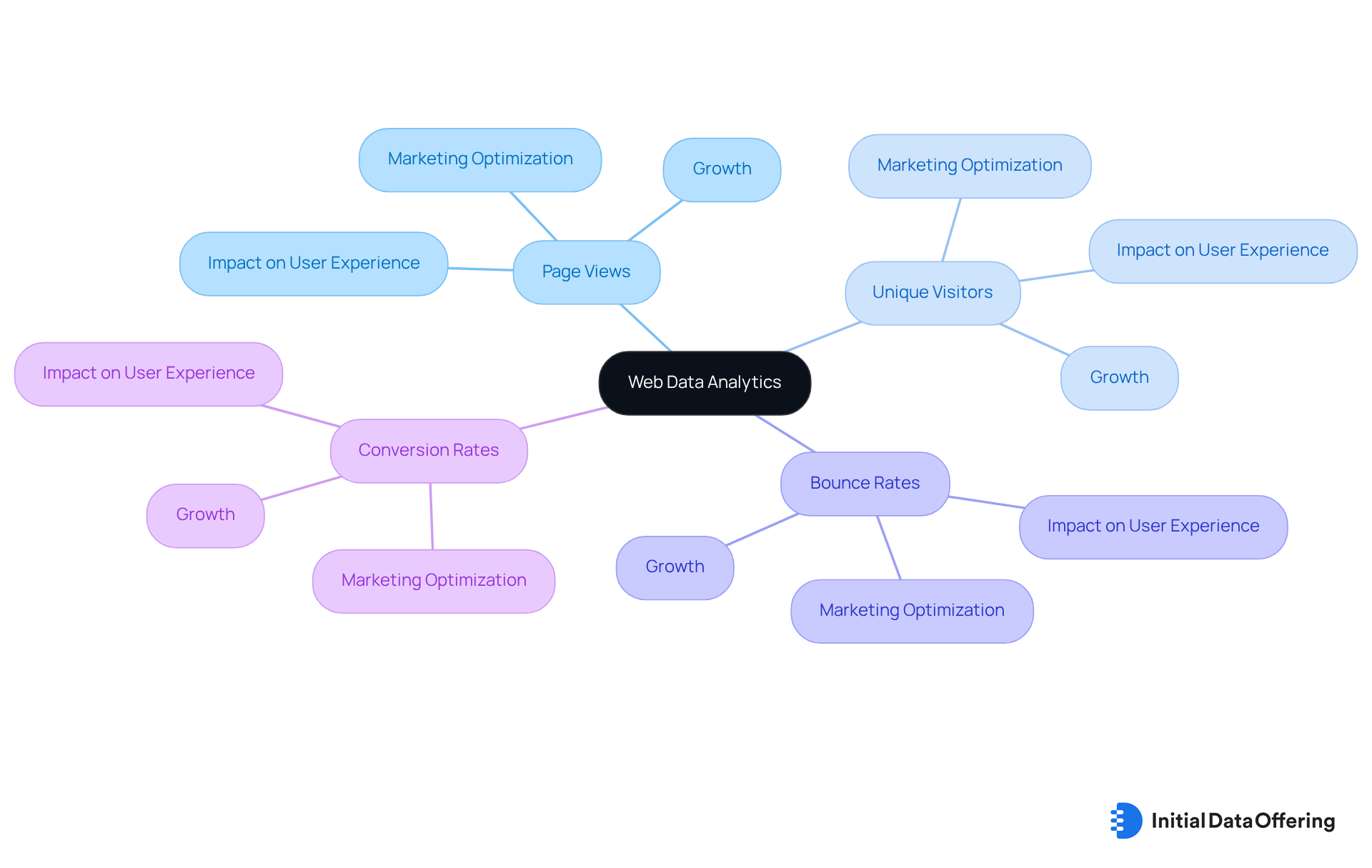
Contextualize Within Data Analytics
Web data analytics is a specialized branch that focuses on analyzing data generated from online interactions. This type of analysis encompasses various methods and tools designed to examine information from diverse sources, with a particular emphasis on the digital landscape. It includes data from websites, social media platforms, and online transactions. As businesses increasingly rely on digital platforms for customer engagement, web data analytics have emerged as a vital resource for understanding market trends and consumer behavior in real-time.
What features make web information analysis essential for modern businesses? By leveraging web data analytics, companies can gain valuable insights into customer preferences and behaviors. The advantages of utilizing this data include enhanced decision-making capabilities and improved marketing strategies. Ultimately, the benefits of web data analytics extend to creating tailored customer experiences, which can lead to increased loyalty and sales.
In conclusion, as the digital environment continues to evolve, the importance of web data analytics cannot be overstated. Companies that effectively harness this data will be better positioned to navigate the complexities of the market and respond to consumer needs promptly.
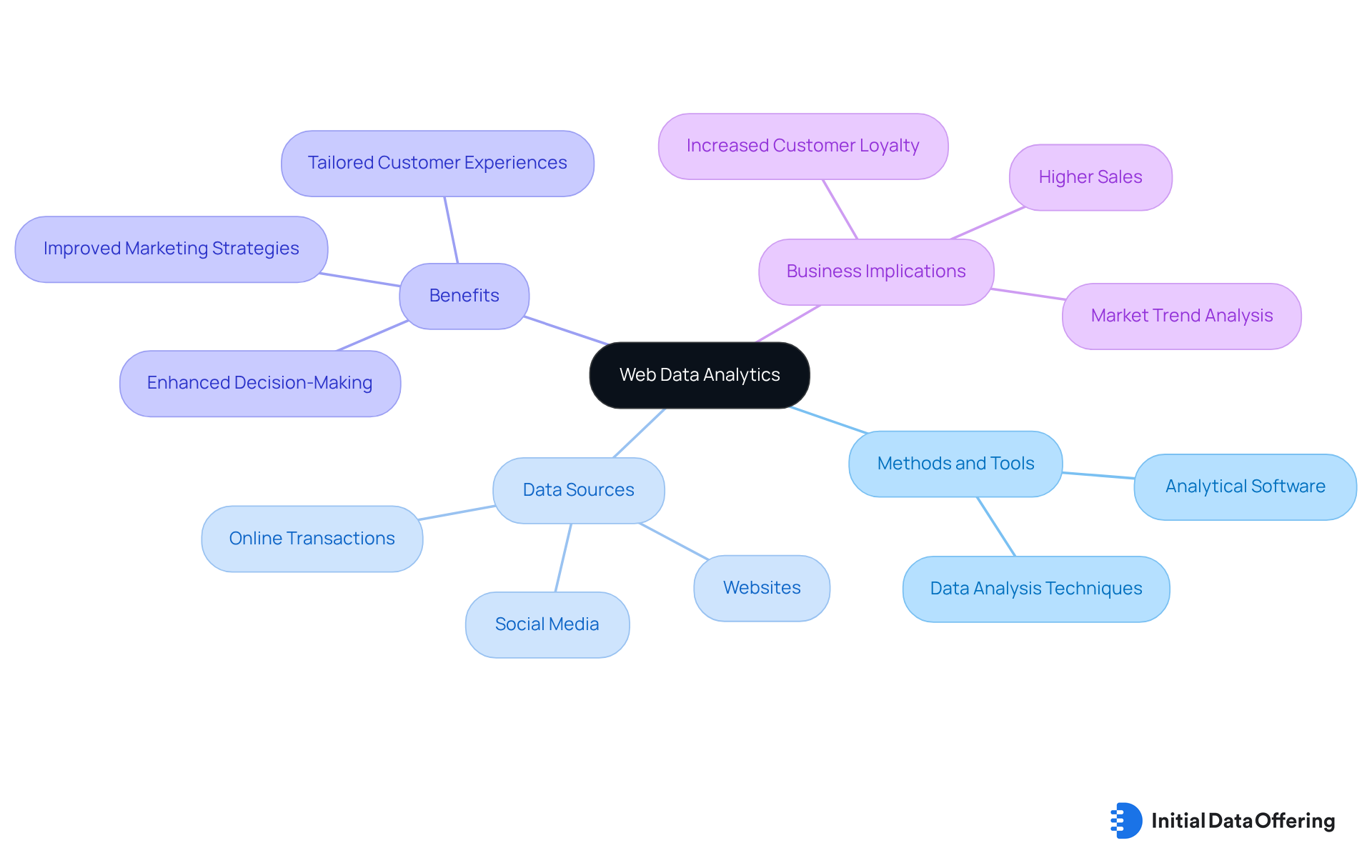
Trace the Evolution of Web Data Analytics
The development of web data analytics is rooted in the early days of the internet, when basic log files were employed to monitor website traffic. As technology evolved, more advanced tools emerged, such as cookies and tracking pixels, which provided deeper insights into individual user behavior through web data analytics. The introduction of Google Analytics in the early 2000s marked a significant turning point in web data analytics, offering businesses user-friendly interfaces and comprehensive reporting capabilities. Today, web data analytics continues to evolve, incorporating artificial intelligence and machine learning to facilitate predictive insights and real-time information processing. This advancement enhances decision-making abilities significantly.
For instance, companies utilizing Google Analytics can effectively track user engagement and conversion rates. This capability allows them to optimize their marketing strategies using web data analytics, ultimately improving their overall performance. Consequently, Google Analytics has become a fundamental tool in web data analytics, with over 14.8 million websites leveraging its features globally. This widespread adoption underscores its crucial role in shaping contemporary web data analytics.
How can your organization benefit from these insights? By understanding and applying these analytical tools, businesses can drive more informed decisions and enhance their online presence.
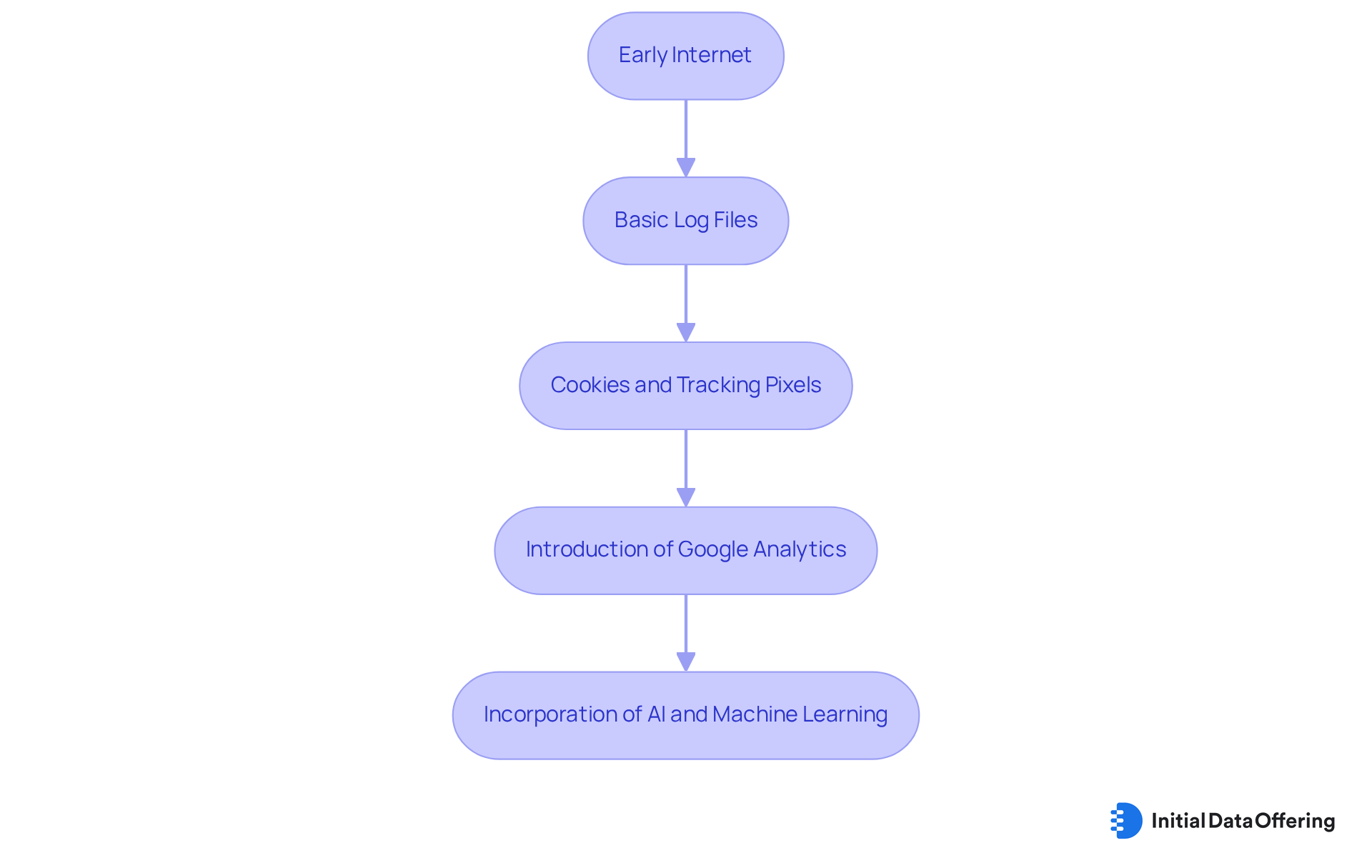
Identify Key Characteristics and Components
Key characteristics of web data analytics encompass collection, processing, and visualization. Data collection involves gathering information from diverse online sources, including website traffic, social media interactions, and user feedback. This information is then processed, which entails cleaning and organizing it to ensure accuracy and relevance. The final step, visualization of information, transforms the analyzed data into easily digestible formats such as charts, graphs, and maps. This enables stakeholders to quickly interpret insights and make informed decisions.
Data visualization is particularly crucial in web analysis. It allows organizations to recognize trends and patterns that may not be readily visible in raw data. For instance, heat maps can illustrate visitor engagement on a website, while line charts can track changes in traffic over time. By employing these techniques, businesses can uncover previously unnoticed opportunities and areas for improvement. Michael Dunlop emphasizes this point, stating, "Data visualization is essential in web analysis," which underscores its critical role in this field.
Furthermore, user segmentation plays an essential part in web data analytics by categorizing users based on behavior and demographics. This segmentation enables targeted marketing strategies, enhancing the effectiveness of campaigns. However, it's important to note that 67% of leaders in analysis stated that organizational culture is the biggest barrier to becoming a company focused on information. This highlights the challenges faced in implementing effective information strategies. As information visualization continues to progress, its significance in web analysis will only increase, enabling faster decision-making and nurturing a metrics-driven culture within organizations.
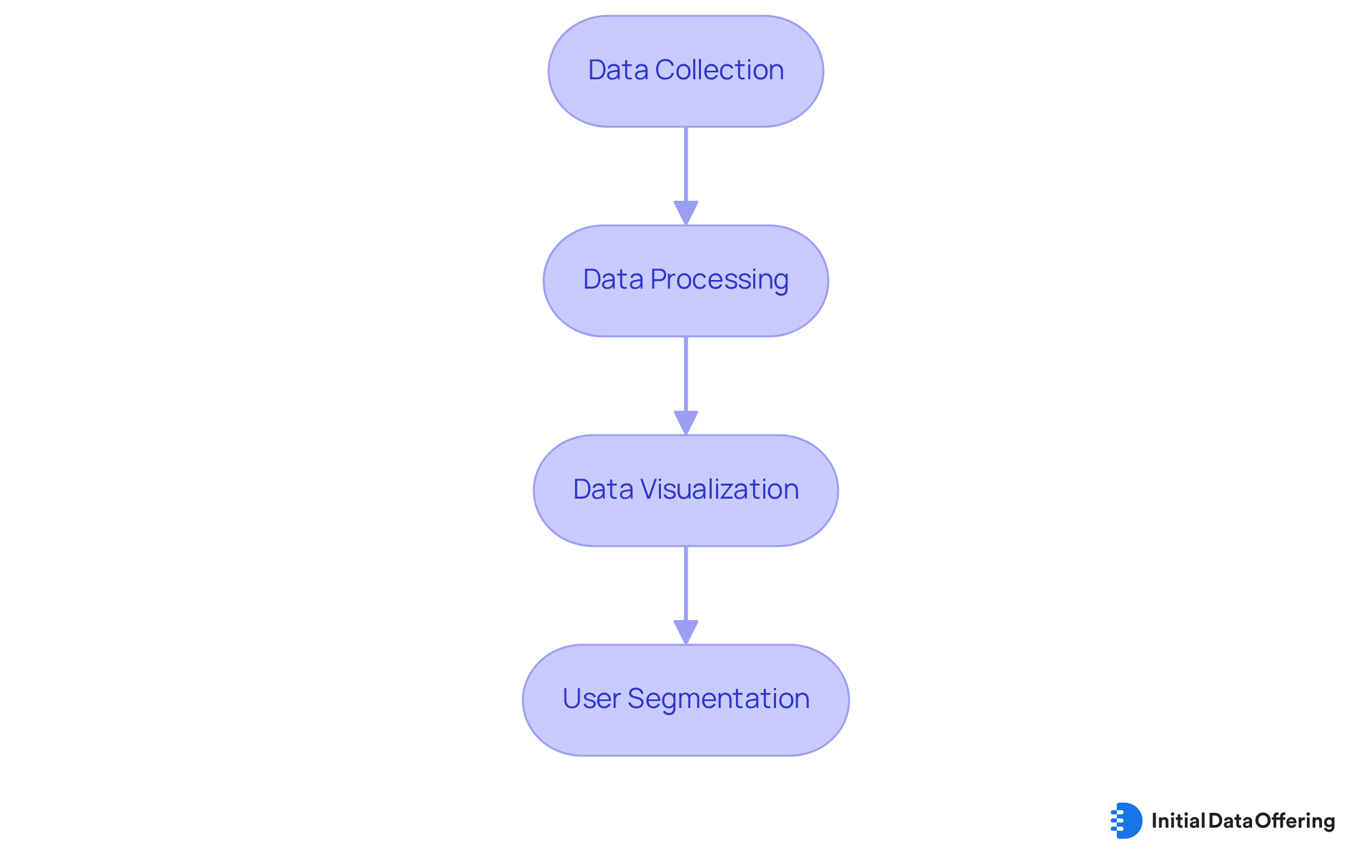
Provide Real-World Examples and Applications
Practical uses of web data analytics are evident across multiple sectors. E-commerce platforms like Amazon utilize web data analytics to monitor user behavior, enhance product suggestions, and improve the overall shopping experience. Research indicates that 91% of shoppers are more likely to purchase from brands that offer relevant suggestions. Furthermore, companies leveraging AI-driven personalization experience a 35% increase in sales, underscoring the significance of customized experiences informed by data insights.
Similarly, news websites analyze visitor data to determine which articles generate the most engagement, allowing them to tailor content to audience preferences. The ability to process information in real-time is revolutionizing digital commerce, enabling news platforms to swiftly adapt to reader interests. In digital marketing, organizations employ web data analytics to evaluate campaign effectiveness, adjusting strategies based on user interactions and conversion rates. Businesses that incorporate AI in E-Commerce Analytics for competitor tracking report a 15-25% increase in profitability, illustrating the transformative power of data in driving business success and enhancing customer satisfaction.
Moreover, the evolving landscape of privacy regulations is prompting businesses to prioritize first-party data over third-party cookies. This shift highlights the challenges that organizations face in implementing effective strategies for web data analytics. How can your business adapt to these changes and leverage data insights for growth?
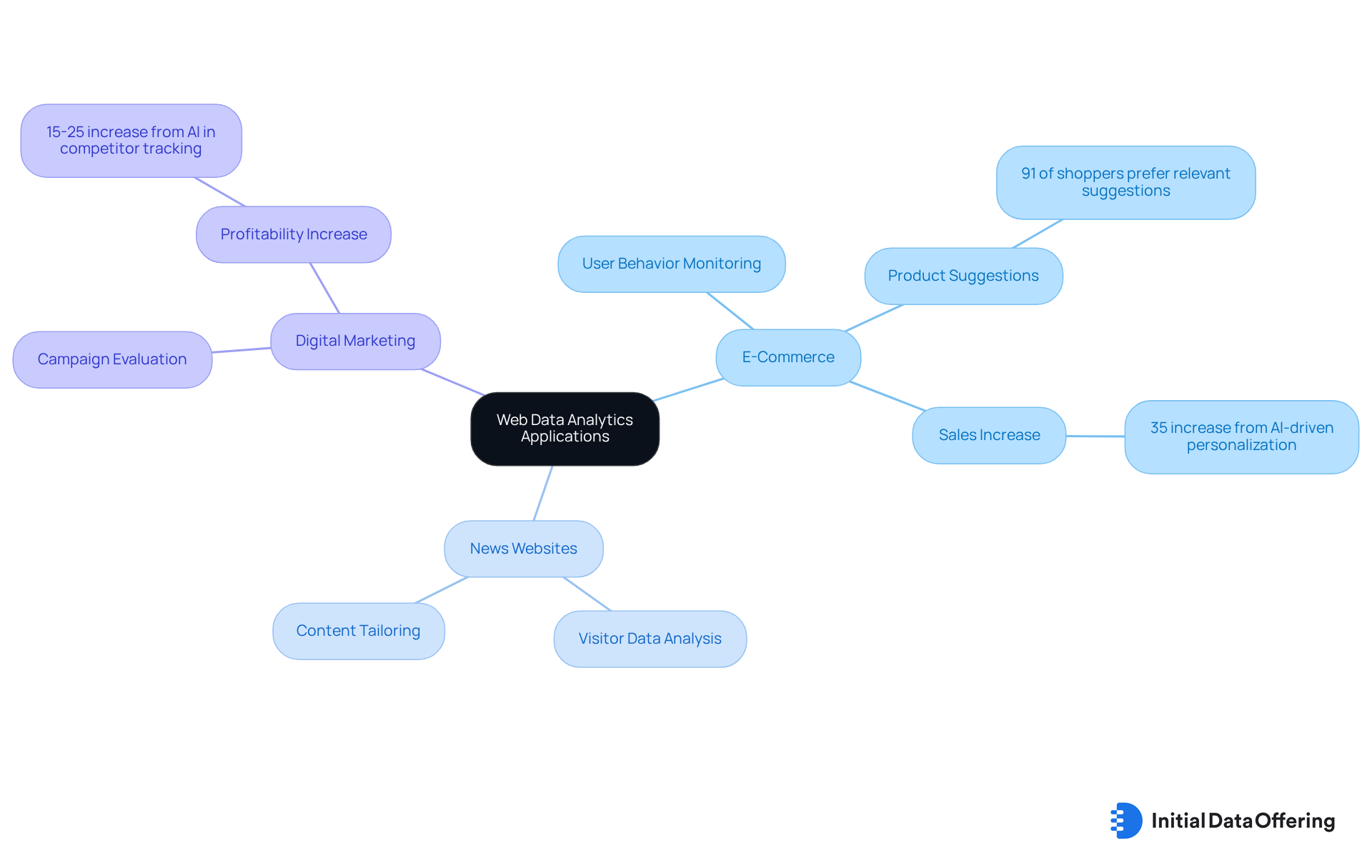
Conclusion
Web data analytics serves as a cornerstone for businesses seeking to enhance their digital presence and understand customer behavior. By systematically gathering and analyzing online data, organizations can gain valuable insights that inform strategic decisions, optimize marketing efforts, and improve user experiences. This analytical approach is not just a luxury but a necessity for companies aiming to thrive in a competitive landscape.
Key points highlighted throughout the article illustrate the evolution of web data analytics from basic monitoring tools to sophisticated systems that incorporate AI and machine learning. The importance of metrics such as page views, conversion rates, and user engagement cannot be overstated, as they provide actionable insights that drive growth. Real-world applications across various sectors, from e-commerce to digital marketing, demonstrate how businesses can leverage these insights to enhance customer satisfaction and boost profitability.
As the digital landscape continues to evolve, the ability to effectively utilize web data analytics will be critical for organizations looking to stay ahead. Embracing these analytical tools fosters a culture of data-driven decision-making and empowers businesses to adapt to changing consumer needs and market trends. The question remains: how will your organization harness the power of web data analytics to drive future success?
Frequently Asked Questions
What is web data analytics?
Web data analytics is an organized method of gathering, measuring, and examining information from online sources to gain insights into visitor behavior, site performance, and overall digital engagement.
Why is web data analytics important for organizations?
It allows organizations to evaluate key metrics such as page views, unique visitors, bounce rates, and conversion rates, which are essential for assessing the effectiveness of their online presence and making evidence-based decisions.
How can web data analytics improve user experience?
By establishing measurable goals that align with overall strategy, companies can use insights from web data analytics to enhance user experience, optimize marketing approaches, and promote growth.
Can you provide an example of how web data analytics has been used effectively?
A fashion retailer used heatmaps and visitor flow analysis to restructure their website navigation, resulting in a 20% increase in average session duration and a 15% boost in sales.
How does web data analytics assist in monitoring campaign performance?
It helps companies track the performance of campaigns across platforms like Google Ads and Facebook Ads, enabling them to identify effective strategies and eliminate unnecessary expenditures to enhance return on investment (ROI).
What role does web data analytics play in achieving long-term growth?
Investing in web data analytics is essential for long-term growth and maintaining a competitive advantage, as it allows companies to understand user engagement metrics and customer needs, refining strategies to improve overall performance.
What types of data are analyzed in web data analytics?
Web data analytics focuses on data generated from online interactions, including information from websites, social media platforms, and online transactions.
How does web data analytics benefit marketing strategies?
By leveraging insights from web data analytics, companies can enhance decision-making capabilities, improve marketing strategies, and create tailored customer experiences, leading to increased loyalty and sales.
What is the future importance of web data analytics?
As the digital environment continues to evolve, the importance of web data analytics will grow, enabling companies to navigate market complexities and respond promptly to consumer needs.